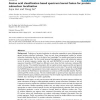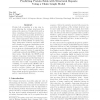15 search results - page 2 / 3 » A simplified approach to disulfide connectivity prediction f... |
EVOW
2010
Springer
13 years 12 months ago
2010
Springer
A challenging problem in bioinformatics is the detection of residues that account for protein function specificity, not only in order to gain deeper insight in the nature of functi...
BMCBI
2010
13 years 8 months ago
2010
Background: Prediction of protein localization in subnuclear organelles is more challenging than general protein subcelluar localization. There are only three computational models...
BMCBI
2007
13 years 8 months ago
2007
Background: Accurate prediction of intra-protein residue contacts from sequence information will allow the prediction of protein structures. Basic predictions of such specific con...
BMCBI
2008
13 years 8 months ago
2008
Background: Recent approaches for predicting the three-dimensional (3D) structure of proteins such as de novo or fold recognition methods mostly rely on simplified energy potentia...
ICML
2005
IEEE
14 years 9 months ago
2005
IEEE
Protein fold recognition is a key step towards inferring the tertiary structures from amino-acid sequences. Complex folds such as those consisting of interacting structural repeat...


